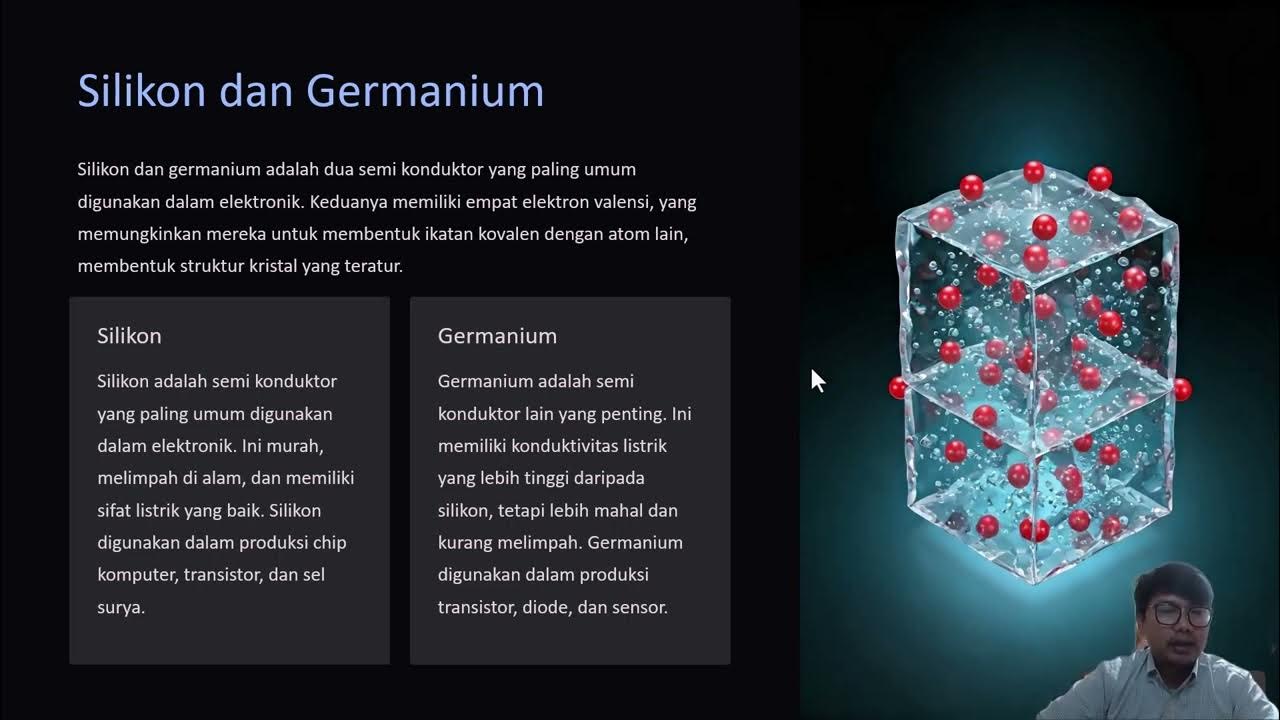SE1x_2022_Week_2_4_1_Charge_carrier_excitation_part_I-video
Summary
TLDRThis video explores the principles behind semiconductor conductivity. It explains how exciting electrons from the valence band to the conduction band enhances conductivity, covering three main methods: using thermal energy, doping with impurities, and utilizing light energy. The concept of the Fermi level is introduced, explaining its role in electron distribution and how temperature changes affect this distribution. The video further discusses the behavior of charge carriers like electrons and holes in semiconductor materials, using silicon as a key example. It concludes with an introduction to doping as a means to manipulate charge carrier concentrations.
Takeaways
- 😀 Semiconductors become more conductive when electrons are excited from the valence band to the conduction band.
- 😀 The three main routes to excite charge carriers in semiconductors are: thermal energy, doping, and light absorption.
- 😀 The Fermi level is a critical concept in understanding how electrons are distributed in a material.
- 😀 In metals, the Fermi level indicates the energy at which there is a 50% chance of an electron occupying that energy state.
- 😀 The Fermi-Dirac distribution function describes the probability of an electron occupying a specific energy state in a material.
- 😀 At absolute zero (0 Kelvin), the Fermi-Dirac function is a step function, meaning electrons occupy all energy states below the Fermi level and none above.
- 😀 For semiconductors, the Fermi level is located in the forbidden band gap between the valence and conduction bands.
- 😀 At higher temperatures, the Fermi-Dirac distribution broadens, allowing some electrons to occupy the conduction band, increasing conductivity.
- 😀 Increasing the temperature of a semiconductor material increases its conductivity as more electrons can occupy the conduction band.
- 😀 Doping semiconductors with impurities can modify their conductivity by increasing the charge carrier concentration in the material.
- 😀 The next step in the series will focus on how charge carrier concentration in a silicon lattice can be manipulated through doping.
Q & A
What is the primary goal when making semiconductor materials conductive?
-The primary goal is to excite electrons from the valence band to the conduction band, allowing the semiconductor to become more conductive.
What are the three methods for exciting electrons to increase conductivity in semiconductors?
-The three methods are: using thermal energy, doping with impurities, and using light energy.
How does thermal energy contribute to the excitation of electrons in semiconductors?
-Thermal energy excites electrons by increasing their kinetic energy, allowing some to jump from the valence band to the conduction band.
What is doping, and how does it help in making semiconductors more conductive?
-Doping involves introducing impurities into a semiconductor material, which helps increase charge carrier concentration and improves its conductivity.
How does light energy help in exciting electrons in semiconductors?
-Light energy excites electrons by providing them with sufficient energy to jump from the valence band to the conduction band, increasing the material's conductivity.
What is the Fermi level, and why is it important in understanding semiconductor conductivity?
-The Fermi level is the energy level at which there is a 50% probability of occupying a state. It is important because it determines the distribution of electrons in the material, influencing its conductivity.
How does the Fermi-Dirac distribution function relate to electron occupancy in metals?
-The Fermi-Dirac distribution function describes the probability that an electron will occupy a state at a given energy level. In metals, lower energy states are fully occupied, while higher energy states are not, especially at absolute zero.
What happens to the Fermi-Dirac distribution function at higher temperatures?
-At higher temperatures, the Fermi-Dirac distribution broadens, increasing the probability of electrons occupying higher energy states.
Why is the Fermi level positioned in the forbidden band gap in semiconductors?
-The Fermi level is positioned in the forbidden band gap because there are no electronic states available for electrons to occupy at this energy level. The electrons are instead distributed between the valence and conduction bands.
How does increasing temperature affect the conductivity of a semiconductor?
-Increasing the temperature allows more electrons to gain enough energy to occupy the conduction band, thus improving the material's conductivity.
Outlines

This section is available to paid users only. Please upgrade to access this part.
Upgrade NowMindmap

This section is available to paid users only. Please upgrade to access this part.
Upgrade NowKeywords

This section is available to paid users only. Please upgrade to access this part.
Upgrade NowHighlights

This section is available to paid users only. Please upgrade to access this part.
Upgrade NowTranscripts

This section is available to paid users only. Please upgrade to access this part.
Upgrade NowBrowse More Related Video

Pengantar Semi Konduktor

Muddiest Points: Electronic Properties II

Types of Semiconductor Materials | Intrinsic & Extrinsic Semiconductor | Engineering Funda

Semiconductors, Insulators & Conductors, Basic Introduction, N type vs P type Semiconductor

Chapter 2 Homog Semicon Fundamentals and Band Structures

Classification of Semiconductors (Intrinsic/Extrinsic, P-Type/N-Type)
5.0 / 5 (0 votes)